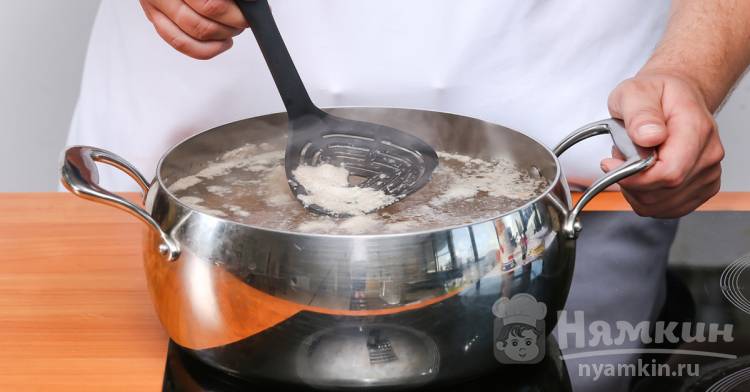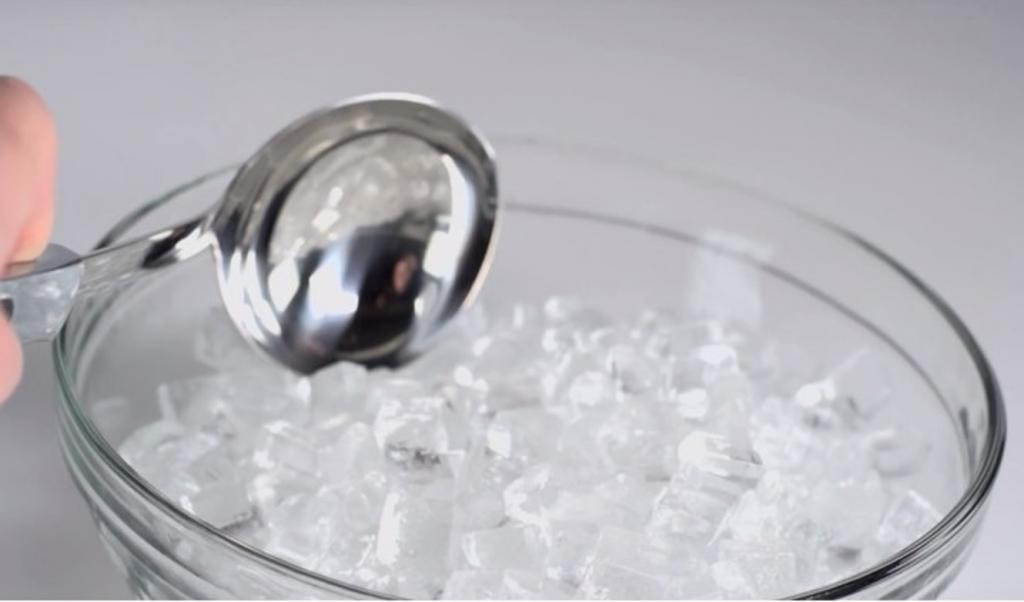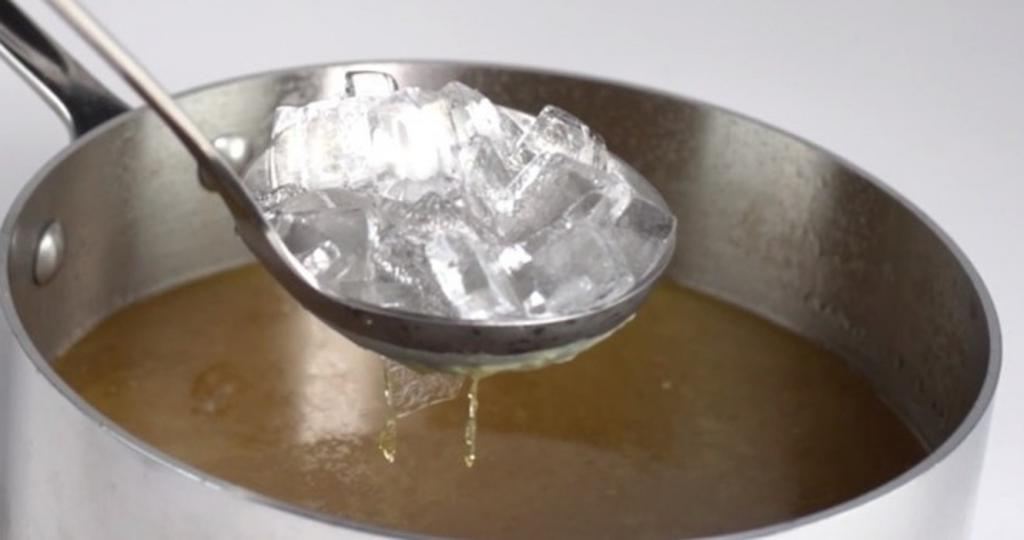Суп получился очень жирный: что делать, как убрать жир
(+0)
15 Октября 2019 14:48
75 тыс
0
Проколы и неудачи на кухне не так уж редки. От них не застрахован ни один самый маститый повар, не говоря уже о начинающих хозяюшках. Стоит лишь отвлечься, пирог может пригореть, молоко убежать. Даже при соблюдении технологии иногда суп получается очень жирный.
Что делать, как убрать жир, знают те, кто имеет опыт или не раз сталкивался с данной проблемой и успешно ее решал. Несколько проверенных способов помогут спасти любимое первое блюдо. К тому ж известно, что жирная еда нездоровая для организма: она тяжело усваивается, медленно переваривается. В результате страдает фигура.
После остывания
Заметив, что суп очень жирный, можно сразу вообще ничего не делать. В таком случае ситуацию спасает холодильник. Если подобный казус случится зимой, кастрюлю лучше вынести на балкон и оставить на холоде до полного остывания.
Жир при охлаждении остается на поверхности супа, но из жидкого состояния переходит в более плотное. Когда суп охладится, на поверхности появится толстая жировая корочка.
Ее легко собрать ложкой. Хочется, чтобы супчик был совсем нежирный, тогда можно собрать весь жирок полностью. При желании часть оставляется. Когда перед употреблением борщ или харчо нагреется, он снова станет равномерным, но жирность не будет такой критичной.
При кипении
Когда суп начинает интенсивно кипеть, на поверхности образуется пенка. Она перемешивается с жиром. В результате к краям подплывает пенно-жировая масса, имеющая очень непривлекательный вид. Любая хозяйка от нее избавляется. Делать это лучше так:
- Огонь под посудой уменьшается до небольшого, так кипени станет слабым, снимать пенку безопаснее и проще.
- Кастрюлю необходимо сдвинуть немного в сторону. Огонь будет нагревать лишь часть дна, поэтому пена прибьется к одной стороне. Ее легко убирать, снимая одновременно и жир.
- Снова поставить суп по центру и доварить до готовности.
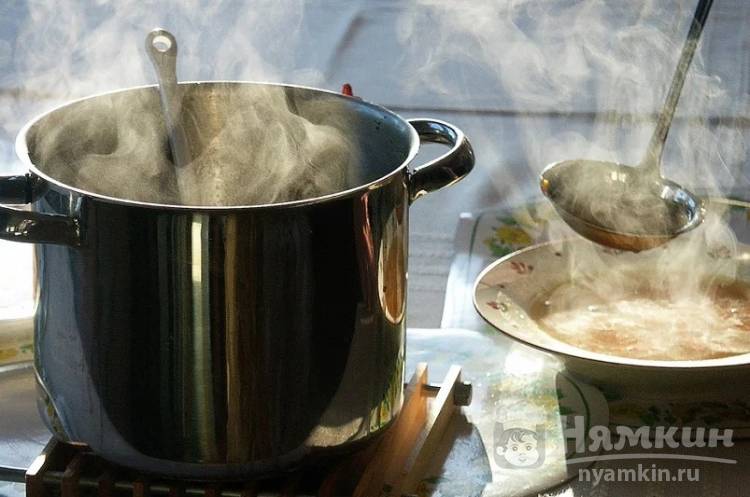
Соусником
Существуют специальные кувшины с носиками, через которые можно процедить бульон, оказавшийся слишком жирным. А если кувшинчика нет, подойдет соусник с носиком.
Как спасти жирный суп:
- Посуду перед использованием придется максимально охладить.
- Перелить суп (без густой массы) в кувшин.
- Дать постоять несколько минут.
- Медленно выливать через носик содержимое в кастрюлю. Можно делать эту операцию несколько раз.
На стенках оседает жир, который надо убирать полотенцем после завершения переливания.
Холодной ложкой
Для спасения жирного наваристого супа берется металлическая ложка и ледяная вода с колотым льдом. Можно аналогично использовать половник, тогда извлекать жир еще быстрее. Некоторые даже применяют сито или дуршлаг. Главное условие – предмет должен быть металлическим, тогда он сможет хорошо охладиться. Пластмассовая кухонная утварь для данного спасения не годится.
Порядок действий:
- Погрузить ложку в слишком холодную воду на несколько минут, чтобы она стала ледяной.
- Нижней частью ложки (сита, половника, дуршлага и т. д.) плавно провести по поверхности жирного супа.
- Вынуть утварь, на которую налип жидкий жир, стряхнуть ее и протереть бумажным полотенцем.
- Снова охладить в воде и повторить процедуру.
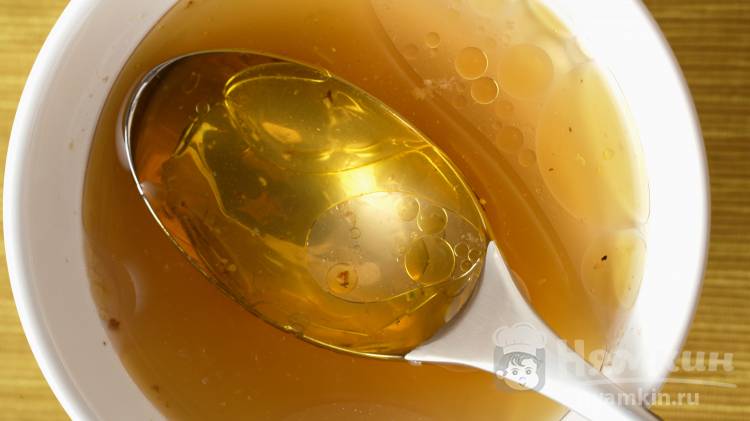
Бумажным полотенцем
Некоторые сетуют на то, что ложкой снимать жир с кипящего супа очень долго, проблематично и опасно. В таком случае можно попробовать второй способ, рекомендуемый домашними Кулибиными. В запасе должно быть несколько бумажных плотных полотенец.
Инструкция спасения первого блюда достаточно простая:
- Когда жирный суп снят с плиты, надо дождаться его частичного остывания.
- Оторвать одно бумажное полотенце от рулона, разложить его на поверхности супа прямо в кастрюле и слегка прижать ложкой.
- Дождаться, пока бумажный спаситель вберет в себя жир (станет влажным).
- Аккуратно с помощью шумовки извлечь полотенце из кастрюли. Важно следить, чтобы оно не размокло и не разорвалось, иначе куски могут остаться в жидкости.
При необходимости эту процедуру можно повторить, пока весь жир не будет собран.
Куском хлеба
Опытные хозяйки говорят, что жир хорошо впитывается в хлеб. Они рекомендуют в случае с наваристым супчиком поступить следующим образом:
- Отрезать ломоть хлеба. Можно брать продукт средней свежести, корочку или слегка подчерствевший хлебушек, тогда он не развалится в горячем супе.
- Опустить хлебную корочку в суп, оказавшийся очень жирным, подержать несколько секунд и вынуть.
- Затем взять другой кусочек и сделать то же самое.
- Весь жирок таким способом не вымакаешь, но частично убрать получится.
Половником
Увидев, что суп получается жирным, надо на время снять его с плиты. Затем половник медленно погружается в жидкость до тех пор, чтобы она постепенно его не наполнила, но поступала при этом с самого верха. Это значит, что в половнике окажется жир и немного бульона. Собранный навар сливается в небольшую мисочку и отправляется в холодильник.
Затем суп можно продолжать варить. В конце готовки содержимое миски в холодильнике остынет. Сверху появится плотный жировой слой. Его придется снять, а остальной бульончик пора вернуть в кастрюлю.
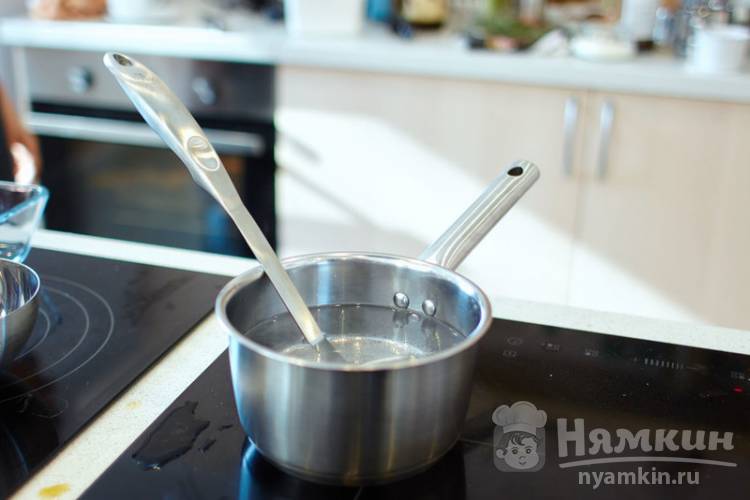
Взбалтыванием
Негустой суп можно быстро взболтать ложкой, тогда на поверхности появится воронка, а капельки жира устремятся к стенкам кастрюли и осядут на них. Останется лишь успевать собирать.
Порядок выполнения:
- Поварешкой или ложкой взболтать быстро суп.
- Пройтись по внутренней поверхности стенок кастрюли бумажным полотенцем или ложкой, собирая жир. Если снимать его ложкой, то в нее попадет немного бульона.
Зная несколько методов, как убрать жир, если суп получился очень жирным, всегда можно решить, что делать, учитывая обстоятельства: количество имеющегося в запасе времени и наличие подручных вспомогательных предметов.
Советуем прочитать
Суп получился очень жирный: хитрости, которые помогут убрать жир
Белновости
10.11.2021 21:30
belnovosti.by@yandex.ru
Обновлено: 07.04.2023 09:51
Ошибки и неудачи — частые спутники человека, и кухня в этом случае не может служить исключением.
Содержание
- 1. Ждите, пока остынет
- 2. Кипятите
- 3. Переливайте
- 4. Пропитывайте
Даже опытные повара ошибаются, да так, что потом приходится спасать готовое блюдо. Но дело не в ошибке, а в умении ее исправить. А это утверждение касается любой сферы деятельности.
Предвидеть абсолютно все просто невозможно, поэтому не огорчайтесь, когда, пытаясь сварить диетический суп, подняв крышку кастрюли, увидите обилие жира.
1. Ждите, пока остынет
Пожалуй, это самый простой совет. Очень жирный суп должен для начала остыть, например, на балконе или в холодильнике, если позволяет температура. После охлаждения на поверхности образуется корка из жира, которую следует просто собрать ложкой.
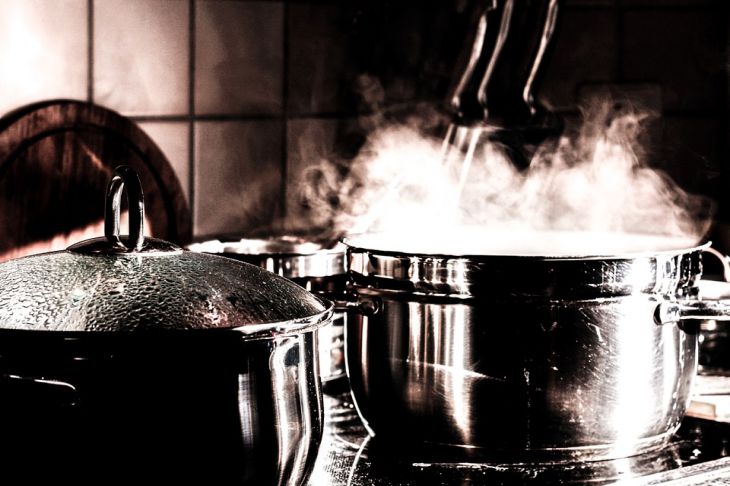
2. Кипятите
При нагревании и кипении на поверхности супа появится пенка с жиром, довольно непривлекательного вида. Сделайте меньше огонь, переставьте кастрюлю чуть в сторону, чтобы нагревался только один ее край.
В результате пена соберется у одного бортика кастрюли, где ее будет легче собрать вместе с жиром.
3. Переливайте
Можно охладить такой суп, после чего перелить бульон в кувшин и дать ему постоять несколько минут. После этого можно перелить через носик сосуда бульон обратно в кастрюлю. Жир будет собираться на стенках кувшина после каждого переливания.
4. Пропитывайте
Можно взять бумажное полотенце и поместить его на поверхности супа, чуть прижав ложкой. Салфетка впитает в себя лишний жир, после чего останется извлечь ее и при необходимости повторить процедуру с новой салфеткой.
Аналогичную процедуру можно провести с помощью куска хлеба.
Последние новости
Главные новости
Как убрать жир из супа, рагу, подливы или бульона?
Несколько несложных способов уменьшить калорийность блюд

Если ваш суп получился слишком жирный — это не повод его не употреблять! Воспользуйтесь одним из следующих способов существенно уменьшить жирность супа. Итак, как же убрать жир из супа, рагу, подливы или бульона?
Способ первый
Поставьте суп или бульон в холодильник. Когда суп достаточно остынет, весь жир соберется на поверхности и его можно будет легко снять ложкой.
Способ второй
Используйте кухонное одноразовое полотенце. Просто положите сверху на суп большой лист кухонного полотенца и подождите пару минут. Жир впитается в полотенце и легко снимется с поверхности супа.
Способ третий
Положите в бульон пару кубиков льда и когда жир соберется в большие плотные капли, соберите его ложкой или шумовкой вместе со льдом.
Способ четвертый
Заверните кубик льда в кухонное полотенце и поводите им по поверхности супа. Лед притянет жир с поверхности и жиринки останутся на полотенце.
Способ пятый, технологичный
Магнит для жира, который с легкостью может собрать весь лишний жир из уже приготовленных или еще готовящихся блюд.
15 Пошаговых, простых рецептов ужинов, по которым точно получится вкусно! Сборник рецептов «Ужины за 30 минут и меньше» . Подробные рецепты, где каждый маленький шаг расписан!
Размещено в рубриках:
Download Article
Download Article
- Simmering Soup
- Warm Broth
- Chilled Soup
- Video
- Q&A
- Things You’ll Need
|
|
|
|
|
Removing the fat from soup and broth can be an essential part of a recipe, or it might be a preference to help you maintain a leaner diet. Skim the soup during the cooking process to get a clearer, leaner broth. Or strain out the broth if you prefer to keep the fat for the cooking process but don’t want to consume it. If you decide to strain your soup, remove the chunks of vegetables, meat, rice, noodles, or bones first so you can strain just the broth. If you’d rather wait until you can remove all of the fat, chill the soup so the fat solidifies. Then it can be easily separated from the lean ingredients. Choose your skimming technique before you start cooking as different techniques require certain tools and timing considerations.
-
1
Bring your soup to a gentle simmer on the stove. When you’re ready to skim off the fat, turn the heat down to medium-high so that the soup gently simmers. You’ll start to see the fat particles floating or foaming towards the top of the stockpot. Don’t allow the soup to continue at a rolling boil.[1]
- Boiling soup over high heat melts the fat, meaning it will blend into the broth. This makes it harder to remove.[2]
- Boiling soup over high heat melts the fat, meaning it will blend into the broth. This makes it harder to remove.[2]
-
2
Stir the liquid so the foaming fat moves to the edges of the stockpot. Submerge a long-handled ladle or wooden spoon into the center of the pot. Stir it around to get the simmering liquid swirling in a circle.[3]
- The stirring movements will cause the oily foam and globules to migrate to the outside edges of the stockpot.
Advertisement
-
3
Scoop up the foaming fat with a fine mesh skimming utensil. Once the oils start to foam up and float on the top of the soup, dip the edge of the shallow skimming utensil just below the surface of the soup. Then lift it upwards quickly to scoop up the foam and fat.[4]
You’ll see some of the foamy fat stuck to the inside of the mesh.- Continue scooping up the fat until there’s enough collected in the mesh to discard.
- Dunk the mesh skimmer in a bowl of water or rinse it off under running water to remove the fat residue.[5]
- This method works particularly well for skimming chicken stock.
-
4
Use the back of a cold metal spoon if you don’t have a mesh skimming utensil. Place a handful of ice cubes into a deep metal spoon or ladle to chill it down. Keep the ice cubes in the spoon while you touch the back of the spoon to the surface of the soup. Glide the back of the spoon gently across the fatty globules. The fat will solidify and stick onto the back of the spoon. Lift up the spoon and discard any fat that’s stuck to the bottom.
- When the cold metal touches the hot soup, the fat that has gathered near the surface will quickly coagulate onto the spoon so you can peel it off.[6]
- Wipe off the fat onto a paper towel and repeat the process to remove all of the fat.
- You must use a metal spoon for this method. A wooden or plastic spoon won’t get as cold.
- Don’t submerge the whole spoon into the soup. Just hold it parallel to the surface of the liquid while the fat gathers on the back of the spoon.
- When the cold metal touches the hot soup, the fat that has gathered near the surface will quickly coagulate onto the spoon so you can peel it off.[6]
Advertisement
-
1
Remove any vegetables, meat, or noodles before straining the soup. Use a slotted spoon to lift out any meat and veggie chunks, noodles, and rice from thicker soups once the soup has cooked completely. Set these aside in a bowl and cover it. Feel free to leave it at room temperature while you cool and strain the broth.
- If you’re making a bone broth, follow the same process to remove and discard the bones.
- To speed up the separating process, cook the soup with a double-layered pasta pot. Insert the strainer layer before adding your ingredients. Everything will be submerged in the stock while you cook the soup, but you can lift out the inner strainer to remove just the chunky pieces. Allow the stock to drain out into the bottom pot.[7]
-
2
Cool the broth until the fat particles just start to solidify. Remove the stockpot from the heat source and allow the soup to cool down slightly, for about 15 to 30 minutes depending on the quantity of soup. Wait until the soup stops bubbling and steaming, and you see the oils float to the top of the stockpot. They don’t need to completely solidify, but you don’t want them to be boiling hot.
- Cooling and straining the broth takes a little extra time. Plan ahead if you’re aiming to have the soup ready by a certain time.
- Leave the soup uncovered as it cools, but don’t stir it around.
-
3
Pour the broth through a gravy separator if you want to skim the fat quickly. Once you’re left with just the liquid broth, carefully pour it from the stockpot directly into a fat-separating pitcher known as a gravy separator, a fat separator, or a skimming pitcher. Set the pitcher aside for 5 minutes or until most of the fat has risen to the top of the soup. Then pour the broth back into the stockpot or a serving bowl.[8]
- The liquid should pass through the spout and the fat should remain trapped inside the pitcher.
- These tools can be found at specialty cookware shops and online retailers. They look like a large measuring jug with a spout extending out from the bottom.
- A bottom-draining fat separator works in a similar way. To use this tool, hold the pitcher over the stockpot or a serving bowl. The broth will drain out into the stockpot while the fat stays trapped inside the pitcher.[9]
-
4
Strain the broth through a kitchen towel if you don’t have a separator. Soak a clean, plain-weave or cheesecloth kitchen towel in cold water and wring it out so it’s damp but not dripping. Arrange the towel as a lining within a sturdy colander. Place the colander within another stockpot or deep serving bowl. Then, carefully pour the broth through the towel-lined colander and into the pot.[10]
- The fat globules will solidify and stick to the cold towel as the rest of the soup runs into the stockpot.
- Choose a stockpot or serving bowl with plenty of space below the bottom of the colander. If it’s too shallow, the soup will fill up around the colander and it won’t strain properly.
- You can also try this technique with a cold, damp coffee filter instead of a cloth towel.[11]
Advertisement
-
1
Chill the soup in the refrigerator overnight. Once you’ve finished cooking the soup, remove it from the heat and cover the stockpot with cling wrap or aluminum foil. Allow it to cool down at room temperature for about 10 to 20 minutes, then place it in the refrigerator. Leave it to chill for at least 6 to 8 hours, or until the fat floats to the top and completely hardens.[12]
- Try to prepare your soup the night before so it has time to chill overnight.
- If you need to serve the soup right away, this technique won’t be suitable. Try skimming the fat while you’re cooking the soup or straining the broth instead.
-
2
Scoop away the solidified fat with a spoon if you’re skimming a thick soup. Once you see a solid layer or solid chunks of light-colored fat solids, they’ll be easy to remove these from the soup. Glide a large spoon underneath the solid pieces of fat and carefully lift them out. Discard the solid fat.
- After removing the fat, reheat the lean soup on the stove or in a microwave before serving it.
- This method works for chunky soups as well as broth.
-
3
Pour chilled soup a hole in a plastic bag if you’re skimming broth. Carefully pour the chilled broth from the stockpot into a resealable gallon-sized plastic bag. Seal the top and hold the bag over a serving bowl or another stockpot. Snip off one of the bottom corners of the bag and allow the broth to pour out into the bowl. The fat solids will get stuck in the bag and can be discarded.[13]
- If you have more soup than can fit in the bag, repeat the process with a second bag and discard the first.
- This technique won’t work for thick soups containing meat, vegetables, noodles, or rice. But it’s great for skimming broth.
Advertisement
Add New Question
-
Question
How do you skim soup without a skimmer?
Drew Hawkins1
Community Answer
A skimmer can be super useful, but if you don’t have one, no worries. You can still skim the fat off of your soup by straining the broth. First, remove any meat and veggie chunks, noodles, and rice from thicker soups once the soup has cooked completely. Let the broth cool until you can see the fat particles starting to solidify. They don’t need to completely solidify, but you don’t want them to be boiling hot. Then, soak a clean, plain-weave or cheesecloth kitchen towel in cold water and wring it out so it’s damp but not dripping. Arrange the towel as a lining within a sturdy colander. Place the colander within another stockpot or deep serving bowl. Then, carefully pour the broth through the towel-lined colander and into the pot. The fat globules will solidify and stick to the cold towel as the rest of the soup runs into the stockpot. Easy!
-
Question
How do you skim fat when cooking?
Drew Hawkins1
Community Answer
Skimming the fat off of soup while it’s still cooking is one of the easiest ways to do it! Start by bringing your soup to a gentle simmer on the stove. When you’re ready to skim off the fat, turn the heat down to medium-high so that the soup gently simmers. You’ll start to see the fat particles floating or foaming towards the top of the stockpot. Then, stir the liquid so the foaming fat moves to the edges of the stockpot. Once the oils start to foam up and float on the top of the soup, dip the edge of a fine mesh skimming utensil just below the surface of the soup and scoop out the fatty foam. Continue scooping up the fat until there’s enough collected in the mesh to discard. That’s all there is to it!
-
Question
Should you skim fat off soup?
Drew Hawkins1
Community Answer
It’s depends on what you’re cooking and whether or not you want to lower the fat content of your soup. Some recipes require you to remove the fat from soup and broth. Skimming the soup also makes it leaner and healthier. So if you’re on a low-cholesterol or low-fat diet, it’s a simple way to make a soup follow your dietary guidelines. It also produces a lighter broth, which can be better for certain types of soup. There are also other benefits of skimming the fat off of soup. You can save and reuse the fat for cooking just like you would use lard or bacon grease. It’s also helpful to skim the fat if you’re making stock because it’ll help preserve the flavors in the broth.
Ask a Question
200 characters left
Include your email address to get a message when this question is answered.
Submit
Advertisement
Thanks for submitting a tip for review!
Things You’ll Need
- Long-handled ladle or wooden spoon
- Fine mesh skimming utensil
- Metal ladle
- Slotted spoon
- Double-layered pasta pot
- Gravy separator
- Kitchen towel
- Colander
- Coffee filter
- Refrigerator
- Cling wrap or aluminum foil
- Spoon
- Gallon-sized plastic bag
References
About This Article
Article SummaryX
To skim off the fat while you’re cooking soup, bring the soup to a gentle simmer over medium-high heat. Don’t let it boil heavily, since this will cause the fat to melt and break up. The fat should start to foam up and make a froth on top of the soup. Stir the center of the broth with a wooden spoon so that the foam moves to the edges of the pot. Then, use a fine mesh skimming utensil to scoop the frothy fat out of the pot. If you don’t have a skimmer, put some ice cubes in a large metal ladle or stirring spoon and skim the back of the cold spoon over the surface of the soup so that the fat sticks to it. Read on to learn how to strain warm broth after it’s cooked!
Did this summary help you?
Thanks to all authors for creating a page that has been read 166,412 times.
Reader Success Stories
-
Carolyn Williams
Oct 27, 2021
«Amazing! There was too much fat from the oxtails in my stew. I found this tip and it worked perfectly. Thank you.»
Did this article help you?
Наваристый и прозрачный. Лишний жир из бульона убираю не шумовкой, а льдом — экономлю время
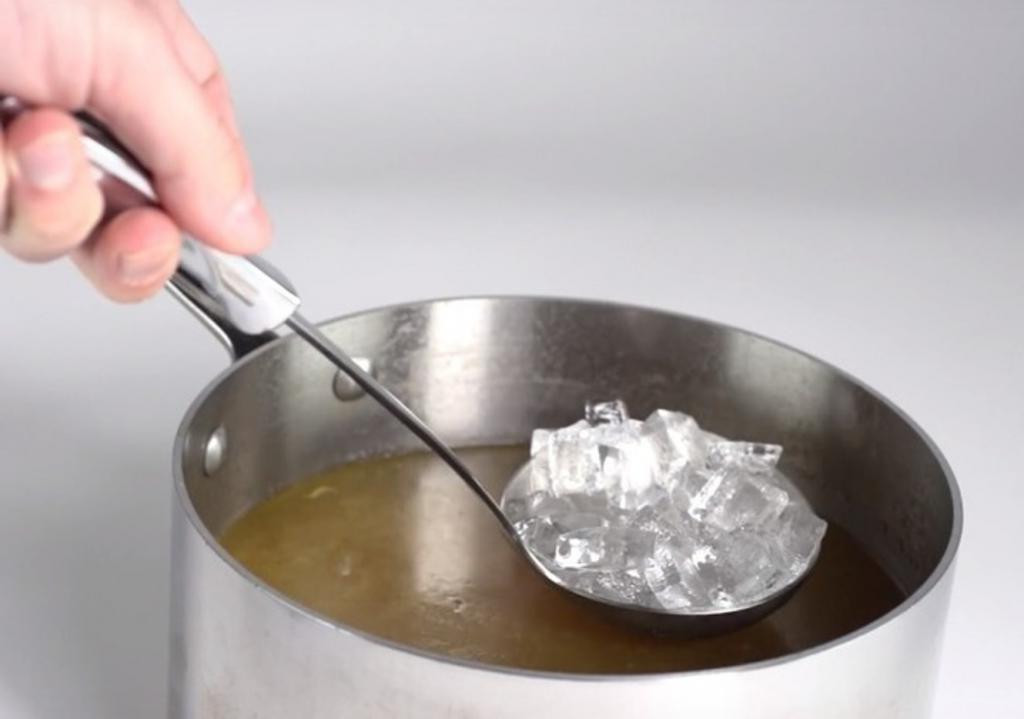
Вашему вниманию представлен самый быстрый и простой способ для того, чтобы убрать жир из супа или борща. Вам теперь не придется долго мучиться и убирать остатки жира с помощью шумовки. В этом деле поможет обычный лед. Чем больше льда, тем эффективнее лайфхак. Это приятный бонус для всех домохозяек.
О том, как сделать суп или борщ намного вкуснее и полезнее, вы узнаете прямо сейчас.
Что нам понадобится
Преимущество такого лайфхака заключается в том, что он простой, быстрый, недорогой и эффективный. Для того чтобы убрать лишний жир из супа, нам понадобятся:
- кастрюля с борщом или с супом;
- металлическая поварешка (половник);
- лед.
Как убрать жир
1. Высыпьте лед в небольшую емкость. Расколите его на небольшие кусочки. Должна получиться небольшая горка. Затем возьмите в руки металлическую поварешку, она же половник. Зачерпните большую горсть льда.
2. Проведите нижней частью половника по поверхности супа, где образуется весь лишний жир от мяса. Нескольких раз будет вполне достаточно.
3. Вы можете увидеть то, как остатки лишнего жира собираются под нижней частью металлического половника. Из-за того, что половник со льдом очень холодный, жир замерзает и прилипает к его поверхности. Соскребите его. Затем повторите ту же самую процедуру, если у вас получился слишком жирный суп или борщ.
Конечно же, шумовкой так же можно убрать весь жир с поверхности бульона, но этот способ, во-первых, очень долгий, во-вторых, — малоэффективный. Поэтому мы крайне рекомендуем вам воспользоваться нашим лайфхаком, который хоть немного, но упростит вашу бытовую жизнь. Теперь вы можете спокойно наслаждаться прозрачным и вкусным бульоном без капли жира. Но если вы любите жирный суп или борщ, то этот способ может вам и не пригодиться.
Если вы знаете еще о некоторых способах, которые помогут избавиться легко и просто от лишнего жира, то поделитесь с нами этим, мы будем очень рады.
Нашли нарушение? Пожаловаться на содержание



